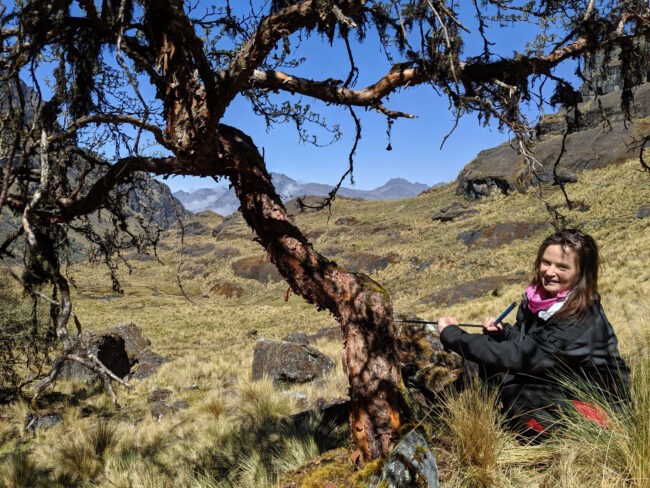Celebrating Women in Science: Tree-Ring Researcher Rose Oelkers
A Q&A with Rose Oelkers, a Ph.D. candidate at the Lamont-Doherty Earth Observatory who studies tropical trees and their response to changes in the environment.
Rose Oelkers, a Ph.D. candidate at the Columbia Climate School’s Lamont-Doherty Earth Observatory, has spent the last several years studying tropical tree species in Bolivia and Peru to understand how they grow and respond to changes in the environment. She credits her interest in tree-ring science to one dedicated professor, Nicole Davi, who introduced her to the discipline when she was an undergraduate initially pursuing ecology.
In the Q&A below, Oelkers reflects on the female researchers who encouraged her to pursue her career, and on the need for increased visibility of women scientists and their research.

What got you interested in science, and tree rings, specifically?
My interest in dendrochronology stems from my undergraduate studies. I was always passionate about ecology and natural systems, but when I went to William Paterson University in New Jersey, I met this really enthusiastic tree-ring scientist in the department of environmental science—Nicole Davi, who’s also an adjunct at Lamont-Doherty Earth Observatory. She was the first person to introduce me to the idea of studying trees to learn more about climate change and the future response of ecosystems to changing environments.
I found it really neat that you could go to your local forest, look at tree rings for a particular time period and relate it to a human memory. For example, if you were around during the drought of the 1960s in the Northeast, you could look at some of the old-growth hemlock tree samples from New York and see small rings that occurred for those years.
I was lucky this professor had a research opportunity and really encouraged going out into the field and doing hands-on work. I kind of fell in love with the idea of being able to get your hands dirty and travel across the world to try to learn more about different environments.
Through Davi, I met some of the great tree-ring scientists at Lamont. To better explore this field, I became a technician at the Tree-Ring Laboratory and was able to work with Rosanne D’Arrigo and Laia Andreu-Hayles on projects studying a variety of biogeochemical parameters of tree rings in Alaska. This experience allowed me to meet and collaborate with other earth scientists like Natalie Boelman, an arctic ecologist who has played a critical role as an enthusiastic mentor. This group of empowering women expressed confidence in my abilities as a scientist, even when challenges arose, and encouraged me to pursue my interests in tree-ring research. Currently, I am lucky to have Laia, Rosanne and Natalie serve as advisors on my Ph.D. committee as I study forest growth and hydroclimate history in the Amazon. I thoroughly believe the motivation and opportunities these women have provided me changed the trajectory of my career.
“This group of empowering women expressed confidence in my abilities as a scientist, even when challenges arose, and encouraged me to pursue my interests in tree-ring research.”
You mention several important women who helped guide you in your research. How can we continue to support and mentor girls and women in science so they have similar opportunities?
We need to continue to increase visibility of the research and the impacts of women in STEM [science, technology, engineering and math]. By normalizing female role models in science, we can create a space for young students to feel empowered in pursuing scientific careers themselves and to collaborate with and celebrate their female peers.
A successful mentor is also a cheerleader. I believe it’s important to proactively encourage young girls to pursue their natural interests and build self-confidence though inclusivity and guidance, regardless of age or experience. By funding educational resources and facilitating connections for internships in the field, we can increase accessibility for young girls to engage in the scientific community.
Do you have any advice for younger women or girls who are interested in entering the field?
Although opportunities for women in science have been restricted by unconscious bias in the geoscience field in the past, don’t be afraid to use your voice, especially in male-dominated environments. Ask the questions. Participate in discussions, share your enthusiasm, and pursue the jobs that you want. You deserve to be in the room, and there is a network of women scientists available to support you.
Meet some of the women scientists at Lamont-Doherty Earth Observatory in our Science for the Planet series; read about others from DEES, IRI and CIESIN; and learn how Columbia University is promoting women in science.
